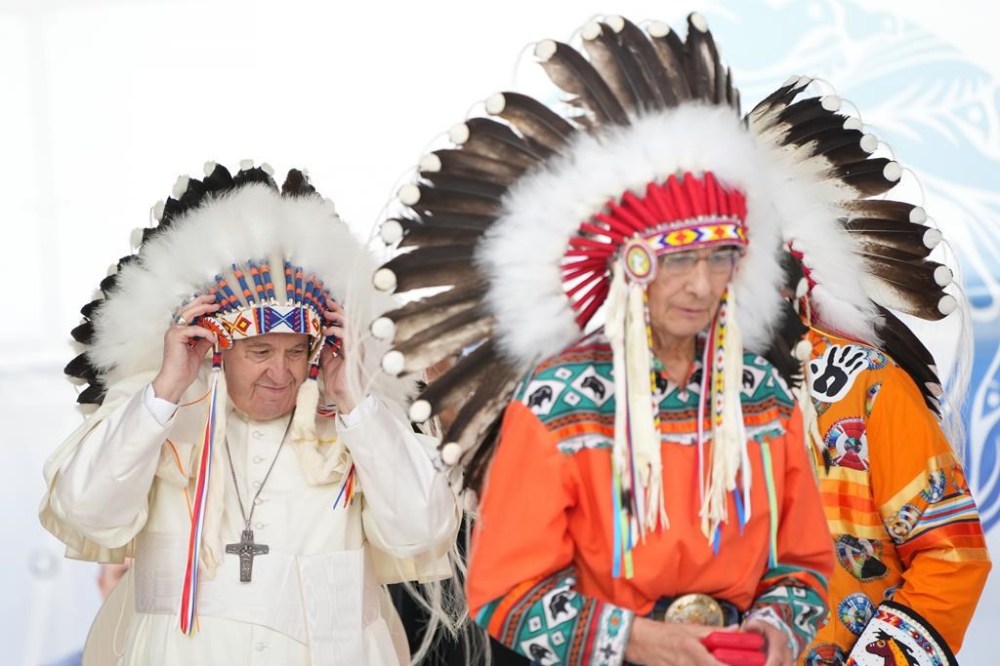Prayers and tears: Scenes from the Pope’s apology for residential schools
Advertisement
Read this article for free:
or
Already have an account? Log in here »
To continue reading, please subscribe:
Monthly Digital Subscription
$19 $0 for the first 4 weeks*
- Enjoy unlimited reading on winnipegfreepress.com
- Read the E-Edition, our digital replica newspaper
- Access News Break, our award-winning app
- Play interactive puzzles
*No charge for 4 weeks then billed as $19 every four weeks (new subscribers and qualified returning subscribers only). Cancel anytime.
Read unlimited articles for free today:
or
Already have an account? Log in here »
Hey there, time traveller!
This article was published 24/07/2022 (839 days ago), so information in it may no longer be current.
MASKWACIS – For minutes Pope Francis sat in his wheelchair, staring at hand-painted crosses marking graves.
A helicopter whirled in the grey sky in the distance. Camera shutters clicked. Otherwise, there was silence.
The 85-year-old pontiff had travelled halfway around the world, on a plane full of officials and international media, to get to Maskwacis, Alta., on Monday.

Near the cemetery, thousands, including the prime minister, the Governor General, chiefs and residential school survivors from across the country, waited to hear his long-anticipated apology on Canadian soil.
Security was tight. Some officers wearing camouflage could be seen on nearby rooftops holding binoculars.
Children chased each other across the grass. Women sat wearing coloured ribbon skirts. Some elders shuffled around with canes, others sat in wheelchairs with blankets tucked around their laps.
Mental health workers passed out bottles of water, bagged lunches and information cards. Some walked around with burning sage.
A 40-metre-long red banner also weaved through the crowd. Listed on it the names of 4,120 children who died in residential schools.
But for those few moments at the cemetery, Francis sat alone, his head down, his hands clutched in prayer. He made the sign of the cross. Then he was ready.
He did not get into his specially designed popemobile for the trip down the road to a large, circular arbour at the community’s powwow grounds where the crowd was gathered.
Instead, he was pushed by an aide, his white cassock flapping in the breeze.
Jon Crier, a residential school survivor, said that before the arbour was built, a wagon trail stretched through the field. He said some parents regularly camped overnight on the bumpy ground so they could wave at their children who were attending the nearby residential school.
Drumming and Indigenous song echoed through Maskwa Park as the Pope got on a stage.
Before the crowd, Francis said, in Spanish, “I’m sorry.”
His cadence was slow.
“I humbly beg forgiveness for the evil committed by so many Christians against the Indigenous Peoples.”
Several times during his address, there was applause. Some cheered. Others held their heads and wiped tears from their eyes. Some listened to the Pope as they embraced the person next to them.
After it concluded, one woman, crying, sung out an impassioned “O Canada” in Cree. In her language, she thanked the Pope for coming and said it was an opportunity for Francis to understand Indigenous Peoples are knowledge keepers of the land.
Another person yelled for the Pope to renounce the Doctrine of Discovery, a legal principle connected to colonization and something many have asked Francis to do.
Gladys Charles and her husband travelled from Prince Albert, Sask., to hear the apology. They were overwhelmed.
“The apology was so touching and we know he said it from his heart,” she said, as Mathew, a survivor, held back a stream of tears with a tissue.
Marie-Anne Day Walker-Pelletier, a retired chief of Okanese First Nation in Saskatchewan, walked up the stage to see Francis, and he gave her a box. Inside, a pair of children’s moccasins — the same slippers she had given him in Rome in March with a plea that he return them on his pilgrimage in Canada.
The Pope said the moccasins kept alive his “sorrow, indignation and shame” over the last few months and symbolize the path forward for healing and reconciliation.
Many crowded the stage, hoping for a brief moment with the pontiff.
Chief Wilton Littlechild walked up a set of stairs holding an elaborate traditional headdress.
He placed it gently on the Pope’s head, its feathers cascading down the sides of the pontiff’s face, while a drummer pounded the steady beat of an honour song. Francis’s face briefly lit up — one of the few times he smiled during the solemn event.
Crier said the gesture honours the Pope for the work he has done.
It was a powerful image, said Sandi Harper, who travelled from Saskatoon for her mother, who went to residential school in Duck Lake.
“This is a step toward healing for many people who are suffering and who are in pain,” she said.
“I think this is one of the biggest steps toward reconciliation.”
This report by The Canadian Press was first published July 25, 2022.
— with files from Kelly Geraldine Malone in Winnipeg.
Note to readers: This is a corrected story. A previous version said the event was held Tuesday.
The Free Press acknowledges the financial support it receives from members of the city’s faith community, which makes our coverage of religion possible.



